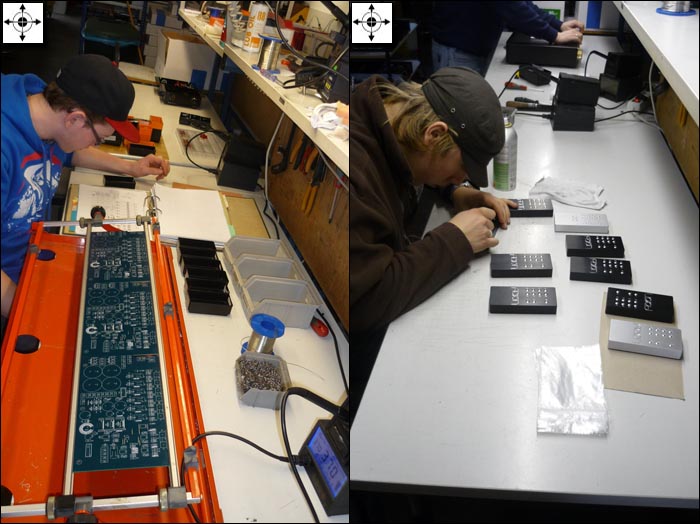This review page is supported in part by the sponsors whose ad banners are displayed below |
 |
 |
Thomas Höhne on cones: "When I sketched out the first Aaron amplifiers during the late 80s, my son Sebastian was just a few years old. And since the apple never falls far from the tree, my youngster was rather too fascinated with electronics. Needless to say, encounters between crawling toddler and integrated amplifiers routinely caused lease-breaking SPLs and heart attacks. What I needed were controls that would slip the grasp of his little fingers. Enter the original slim pointy cone. It became an Aaron signature trait. Though reshaped now, it continues to today."
|
|
|
 |
On manufacture: "Our company headquarters are in Elze/Germany while assembly has been in Hertogenbosch/Holland since 1989."
|
 |
On circuitry: "All Aaron power amps—as well as the Reference Sovereign amplifiers—avoid the common collector or emitter follower circuit configuration which 95% of the competition uses. We use the common emitter approach where the signal enters the transistors at the base and exits out the collector which increases current gain. The Aaron XX topology is a DC-coupled four-stage class A/B circuit with low global feedback."
|
|
|
On heavy lifting: "All Aaron/Sovereign amps are to be as universal as possible and not restricted for use with just civilized 8-ohm speakers. Like its bigger siblings, the Aaron XX handles challenging impedance swings well below 2 ohms, high back EMF and demanding phase angles."
|
 |
On signal paths: "As is easy to see, the output stage of the Aaron XX occupies a single circuit board whereas the externally similar N°.1a runs mono boards. Regardless, we're sticklers about short signal paths."
|
 |
On bandwidth: "We believe that the signal should encounter the lowest possible parts density. We use a special single-sided board with symmetrical layout. Phase splitting occurs at the input of the power buffer. For stability reasons, all Aaron amplifiers rely on specially selected bipolar output transistors. We use a special silver-free solder to maintain phase coherence in our wideband (DC to >120.000Hz) output stages. Here the XX benefits from the newest high-speed ring-emitter bipolar transistors from ON Semiconductor."
|
 |
 |
On measurements & listening: "Besides expensive Audio Precision test bench gear for QC, each finalized Aaron amplifier must pass the harshest critics of our ears during real auditions with music. Such auditions of course also inform circuit and parts decisions during the development process from prototype to formal production. We rely exclusively on small-scale domestic assembly and all the various mechanical parts of our machines exploit modern CNC machining rather than casting or injection molding. If you don't care about your own domestic infrastructure and prefer to support cheaply outsourced labor with 'Western' brands who fill their own coffers with the difference, you probably won't appreciate our efforts to keep things European and be proud of it."
|
|
 |
Features: Beyond the obvious socketry—six line-level inputs, variable and fixed outputs for biamping, subwoofing or to feed a headphone amp—there's standby/on by pushing the rotary volume control in since, hurray, there's no rear-mounted mains which you'd never get to in many installations. Then there's a hidden option. Push the source selector in. This calls up a sub menu. There you can pre-attenuate each input by up to 6dB to equalize output when switching sources of different voltages.
|
 |
While in this menu, rotating the input selector still selects the input you want to program. The volume control range now is simply limited from 0dB to -6dB to set the desired trim. Another push on the input selector exits the menu again.
The inputs on the white-lettered blue display are pre-named but curiously don't match those on the remote. For brevity's sake, the wand's inputs are simply numbered 1 through 8 (with 7 and 8 obviously inactive for the XX model) while 'P' stands for power. There's no transformer hum of any kind and the top panel is quite well damped by the deeply engraved trademark dress plate.
|
|
|
 |
For the highest resolution speakers I had available to mate to the Aaron without breaking the bank, I leashed up Anthony Gallo's new Reference 3.5. The most interesting comparison amp in my inventory was the $3000 Nelson Pass FirstWatt F5. Like the Aaron, it's DC-coupled to avoid coupling capacitors. Then it diverges by being pure class A and a simpler 2-stage circuit with Mosfet outputs. I also still had the Blue Moon awarded April Music Stello Ai500 integrated. At $3.495, a March 2010 currency converter made its sticker equivalent to €2.500 over the Aaron's €2.000. For that surcharge, the Ai500 ups power to 150/300wpc into 8/4 ohms and adds much functionality by way of fixed i/o ports, a special iPod input with full remote transfer and a quality D/A converter with USB.
Front end duties were handled by a 1TB iMac streaming WAV and AIFF files via 800 Firewire to a Weiss DAC2; or by the Weiss passing an S/PDIF signal via Stealth Audio Cables Varidig to my customary Yamamoto YDA-01 SET converter (single-ended transistor, zero negative feedback, resistor-based I/V conversion). To minimize variables in comparisons with the F5, I used my Esoteric C-03 preamp in zero-gain setting (its volume control bypassed for the Aaron to then set levels with the XX control). Outside direct A/Bs, I of course ran the XX as an integrated. That requires no preamplifier to save money and reduce box clutter.
|
|
 |
|
 |
  |
 |